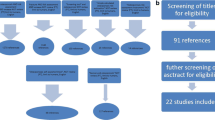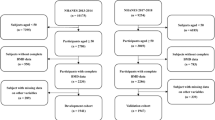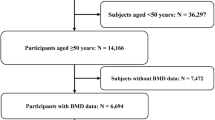Abstract
Osteoporosis risk factor assessment is of uncertain utility in women under 65 years of age. Previous comparative studies of osteoporosis risk assessment tools were not stratified by age. We compared the discriminatory ability of three previously validated osteoporosis risk assessment tools in a referral population of postmenopausal women aged 45–64 years (n=2539) and aged 65–96 years (n=1496) seen at a university-based outpatient osteoporosis center in Belgium. Risk scores for the Osteoporosis Self-assessment Tool, Osteoporosis Risk Assessment Instrument, and Simple Calculated Osteoporosis Risk Estimation were calculated for each patient. The reference standard was osteoporosis at the femoral neck, defined as a T-score ≤−2.5 based on bone mineral density measured by dual energy X-ray absorptiometry. Osteoporosis was present in 139 of 2539 (5.5%) women aged 45–64 years and 241 of 1496 (16.1%) women aged 65 years or older. The tools had similar overall discriminatory ability to identify women with osteoporosis [area under the ROC curve 0.750–0.768, P=0.23 for women aged 45–64 years; area under the ROC curve 0.745–0.762, P=0.06 for women aged 65 years or older (P>0.05 indicates no difference among tools)]. The likelihood ratios for the high-risk score categories ranged from 3.60 to 6.73 for the younger women and 3.45 to 6.99 for the older women when different score thresholds were set to maximize the performance of each tool in each age group. We conclude that the diagnostic accuracy of three osteoporosis risk assessment tools was similar in postmenopausal women aged 45–64 years and women aged 65 years or older. Use of structured risk assessment tools to identify women at high risk of osteoporosis in the early postmenopausal period warrants further study. Of the three tools evaluated, the OST is the simplest and has the best potential for use in clinical practice.
Similar content being viewed by others
References
USPSTF (2002) Screening for osteoporosis in postmenopausal women: recommendations and rationale. Ann Int Med 137:526–528
Nelson H, Helfand M, Woolf S, Allan J (2002) Screening for postmenopausal osteoporosis: a review of the evidence for the US Preventive Services Task Force. Ann Int Med 137:529–541
Siris E, Miller P, Barrett-Connor E, Faulkner K, Wehren L, Abbott T et al. (2001). Identification and fracture outcomes of undiagnosed low bone mineral density in postmenopausal women: results from the National Osteoporosis Risk Assessment. JAMA 286:2815–2822
Koh L, Ben Sedrine W, Torralba T et al. (2001) A simple tool to identify Asian women at increased risk of osteoporosis. Osteoporos Int 12:699–705
Cadarette S, Jaglal S, Kreiger N, McIsaac W, Darlington G, Tu J (2000) Development and validation of the Osteoporosis Risk Assessment Instrument to facilitate selection of women for bone densitometry. CMAJ 162:1289–1294
Lydick E, Cook K, Turpin J, Melton M, Stine R, Byrnes C (1998) Development and validation of a simple questionnaire to facilitate identification of women likely to have low bone density. Am J Man Care 4:37–48
Ben Sedrine W, Chevallier T, Zegels B et al. (2002) Development and assessment of the Osteoporosis Index of Risk (OSIRIS) to facilitate selection of women for bone densitometry. Gynecol Endocrinol 16:245–250
Black DM, Palermo L, Abbott T, Johnell O (1998) SOFSURF: a simple, useful risk factor system can identify the large majority of women with osteoporosis (abstract). Bone 23:S605, Abstract SA333
Weinstein L, Ullery B (2000) Identification of at-risk women for osteoporosis screening. Am J Obstet Gynecol 183:547–549
Ben Sedrine W, Devogelaer J, Kaufman J-M et al. (2001) Evaluation of the Simple Calculated Osteoporosis Risk Estimation (SCORE) in a sample of white women from Belgium. Bone 29:374–380
Faulkner KG, Gluer CC, Estilo M, Genant HK (1993) Cross-calibration of DXA equipment: upgrading from a Hologic QDR 1000/W to a QDR 2000. Calcif Tissue Int 52:79–84
Tothill P, Hannan WJ (2000) Comparisons between Hologic QDR 1000 W, QDR 4500A, and Lunar Expert dual-energy X-ray absorptiometry scanners used for measuring total body bone and soft tissue. Ann N Y Acad Sci 904:63–71
Looker A, Wahner H, Dunn W et al. (1998) Updated data on proximal femur bone mineral levels of US adults. Osteoporos Int 8:468–489
World Health Organization (1994) Assessment of osteoporotic fracture risk and its role in screening for postmenopausal osteoporosis. WHO Technical report series no. 843. World Health Organization, Geneva
StataCorp (2003) Confidence intervals for means, proportions, and counts. In: Stata Statistical Software: Release 8.0 User’s Guide, Volume 1. College Station, Stata Corporation, Tex., p 166
Jaeschke R, Guyatt G, Lijmer J (2002) Diagnostic tests. In: Guyatt G, Drummond R (eds) Users’ guides to the medical literature: a manual for evidence-based clinical practice. AMA Press, Chicago, pp 121–139
Cadarette S, Jaglal S, Murray T, McIsaac W, Joseph L, Brown J (2001) Evaluation of decision rules for referring women for bone densitometry by dual-energy x-ray absorptiometry. JAMA 286:57–63
Cadarette SM, McIsaac WJ, Hawker GA, Jaakkimainen L, Culbert A, Zarifa G, Ola E, Jaglal SB (2004) The validity of decision rules for selecting women with primary osteoporosis for bone mineral density testing. Osteoporos Int Jan 17 (Epub ahead of print, accessed February 15, 2004)
Geusens P, Hochberg M, van der Voort D et al. (2002) Performance of risk indices for identifying low bone density in postmenopausal women. Mayo Clin Proc 77:629–637
Mulherin S, Miller W (2002) Spectrum bias or spectrum effect? Subgroup variation in diagnostic test evaluation. Ann Int Med 137:598–602
Looker A, Johnston Jr C, Wahner H et al. (1995) Prevalence of low femoral bone density in older US women from NHANES III. J Bone Miner Res 10:796–802
Ben Sedrine W, Broers P, Devogelaer J et al. (2002) Interest of a prescreening questionnaire to reduce the cost of bone densitometry. Osteoporos Int 13:434–442
Acknowledgements
The authors thank Darren DeWalt MD and Michael Pignone MD, MPH for their helpful comments on this manuscript.
Author information
Authors and Affiliations
Corresponding author
Rights and permissions
About this article
Cite this article
Gourlay, M.L., Miller, W.C., Richy, F. et al. Performance of osteoporosis risk assessment tools in postmenopausal women aged 45–64 years. Osteoporos Int 16, 921–927 (2005). https://doi.org/10.1007/s00198-004-1775-2
Received:
Accepted:
Published:
Issue Date:
DOI: https://doi.org/10.1007/s00198-004-1775-2




